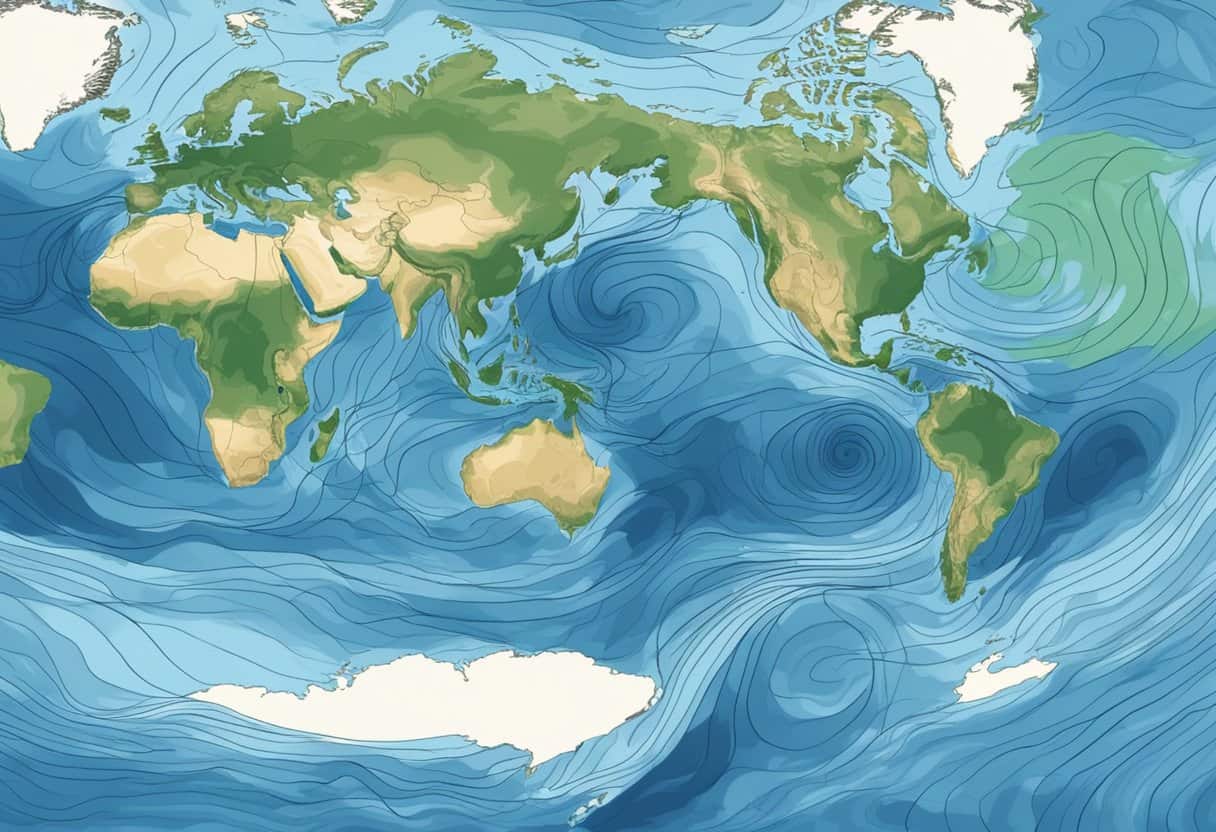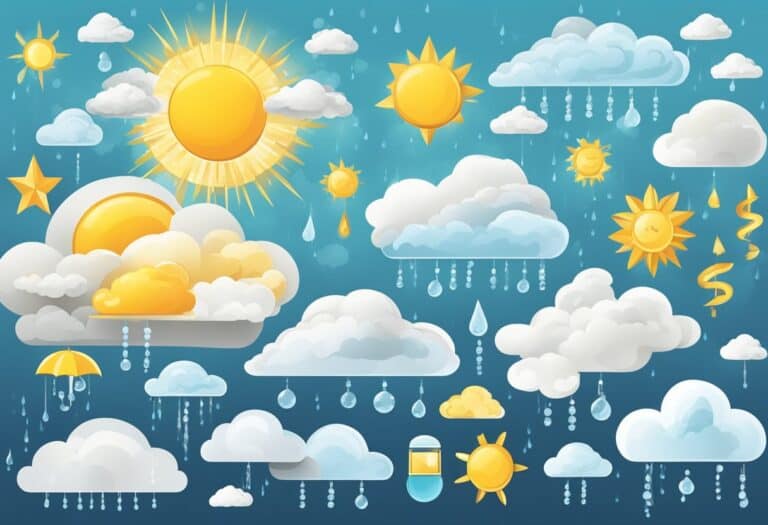Ocean currents play a critical role in shaping the weather patterns you experience daily.
Driven by factors such as the rotation of the Earth, wind, salinity, and water temperature differences, these powerful movements of water distribute heat across the planet.
The transfer of heat from the equator toward the poles creates a balance that influences weather systems globally. When you feel a warm ocean breeze or experience a sudden storm, these events can often be traced back to the effects of ocean currents.
At a regional level, the impact of ocean currents on climate is both profound and complex. Currents like the North Atlantic’s Gulf Stream affect temperature and humidity, leading to seasonal weather changes. They can also moderate extreme weather conditions, making certain regions more habitable.
Understanding the connections between ocean currents, heat transfer, and weather patterns is crucial for appreciating how these vast watery highways steer not just the climate but also impact the physical and ecological systems on Earth.
Ocean currents are vital in shaping global weather patterns by distributing heat from the equator to the poles. This process influences regional climates, affects temperature and precipitation, and can moderate extreme weather conditions. Understanding the dynamics of ocean currents is essential for predicting weather events and their broader ecological impacts.
The Nature of Ocean Currents
In exploring how ocean currents influence our global climate, you’ll discover the compelling dynamics of these vast, continuous flows of seawater. They act as the Earth’s cardiovascular system, distributing heat and nutrients across the globe.
Defining Ocean Currents
Ocean currents are horizontal and vertical movements of seawater that vary in size, strength, and depth. Surface currents comprise water to a depth of about 400 meters and are primarily driven by wind. On the other hand, deep water currents involve movements at depths below this level, influenced mainly by water density differences and topography.
Types of Ocean Currents
You find two main types of currents in the ocean: surface currents and deep water currents. Surface currents, such as the well-known Gulf Stream, are mostly wind-driven and tend to be faster and warmer. Deep water currents, forming a global conveyor belt, are colder, slower, and result from variations in water density.
- Surface Currents: Driven by wind, affected by the Coriolis effect, and largely responsible for weather patterns.
- Deep Water Currents: Motivated by density differences, they work alongside surface currents to regulate the global climate.
Determining Factors of Current Flow
Several key factors influence the direction and speed of ocean currents:
- Temperature: Warmer water expands, reducing density and influencing current flow.
- Salinity: High salt content in seawater increases density, affecting movement.
- Wind: Surface winds impart energy to the sea surface, initiating current flow.
- Coriolis Effect: This phenomenon causes currents to turn to the right in the Northern Hemisphere and to the left in the Southern Hemisphere, impacting the direction of flow.
Your appreciation for these currents will deepen as you recognize their role in sculpting weather patterns and maintaining ecological balance.
Heat Transfer and the Global Climate
As you explore the importance of oceans in climate systems, understanding the mechanisms of heat transfer is fundamental. Oceans play a crucial role in moving warmth from the equator to the poles, influencing your local weather patterns and the global climate.
Impact of Ocean Currents on Global Temperatures
Ocean currents act as massive conveyors of heat. They carry warm water from the equatorial regions toward the poles and bring colder water back toward the equator. This redistribution of heat affects global temperatures profoundly. For instance, the presence of warm ocean currents can mitigate colder climates at high latitudes.
Role in Distributing Heat Around the Planet
The global climate is, in part, regulated by the ocean’s ability to absorb, store, and transfer heat. The vastness of the oceans allows them to hold large amounts of heat energy. Here are the ways in which this affects you:
- Thermal Inertia: Oceans have a high heat capacity, which means they can absorb a lot of heat without a significant increase in temperature, buffering against rapid temperature changes.
- Climate Moderation: Areas near the coast experience milder climates because the ocean absorbs heat in the summer and releases it during winter.
The Conveyor Belt Theory
The concept of the global conveyor belt—also known as thermohaline circulation—describes how water moves through the world’s oceans. Heat, salt concentration, and water density interplay to create this large-scale ocean circulation. Here’s how it works:
- Warm, salty water moves along the surface.
- It cools down as it travels towards the poles.
- As it cools, the water becomes denser and begins to sink.
- Cold water travels back along the ocean floor towards the equator to be warmed again.
This cycle is a principal driver for distributing oceanic heat, impacting climate change. Changes in this circulation can have significant effects on the climate system, potentially altering weather patterns and the distribution of marine life.
Effects on Weather Systems

Ocean currents have a significant impact on weather systems globally, including the regulation of temperature and participation in the formation of storms. Their influence is dynamic, affecting everything from local weather conditions to global wind patterns.
Influence on Wind Patterns and Precipitation
Ocean currents, both warm and cold, play pivotal roles in shaping wind patterns and precipitation. Warm water bodies release heat into the atmosphere, which leads to the creation of low-pressure zones. These zones attract moist air, which can lead to increased precipitation in adjacent regions. For example, the Gulf Stream is known to carry warm water northward, influencing the climate of Western Europe with milder winters and ample rainfall.
Conversely, cold currents often lead to drier conditions. The presence of a cold current off a coastline, such as the California Current, can result in decreased air temperature and reduced rain, impacting the local weather profoundly.
Ocean Currents’ Role in Storm Formation
The formation and intensity of storms, particularly tropical cyclones, are directly influenced by ocean currents. Warm currents can energize storms by providing abundant warm water, which increases evaporation and the accumulation of moisture in the air. This is a critical factor in the development of powerful hurricanes in the Atlantic, where warm waters fuel the storm’s energy, potentially leading to severe weather events.
Modifying Local Weather Conditions
The impact of ocean currents extends beyond the macro scale of weather systems, also affecting local weather conditions. Currents have a moderating effect on the climate of coastal areas, with warm currents potentially elevating temperatures and cold currents having a cooling effect.
Areas adjacent to warm currents, such as the eastern coastlines of continents, often experience mild weather, whereas regions near cold currents may be characterized by cooler, foggy weather. The Canary Current, for example, cools the air along the northwest coast of Africa, often leading to lower air temperatures and the formation of sea fog.
By understanding the roles ocean currents play in governing weather patterns, you can appreciate their significance in both daily weather and long-term climate trends.
Ocean Currents and Regional Climates
Ocean currents play a crucial role in shaping the climate and weather patterns of different regions around the globe. Your understanding of how temperatures and precipitation can change across various areas can be significantly enhanced by examining the influence of these vast water movements.
Europe’s Climate and the Gulf Stream
The Gulf Stream, a warm and powerful Atlantic Ocean current, is a key factor in maintaining the mild climate of Western Europe. Despite Europe’s northern latitude, which is on par with cold regions in North America, the Gulf Stream’s warmth significantly moderates temperatures. This oceanic current ensures your winters are less severe and summers pleasantly warmer than other regions at the same latitude.
The North Atlantic’s Effect on Weather
The North Atlantic Ocean not only influences Europe but also plays a pivotal role in the weather systems across the North Atlantic region. The mechanics of the Atlantic Meridional Overturning Circulation (AMOC), which includes the Gulf Stream as part of a larger conveyor belt of currents, can impact weather patterns. When the AMOC is strong, you experience enhanced warming and more stable weather. On the other hand, a weakening AMOC may lead to more extreme weather events.
Equatorial Regions and Ocean Circulation
In equatorial areas, ocean circulation affects your local climate differently compared to the North Atlantic. The ocean currents in these regions redistribute heat and can influence rain patterns substantially. For instance, oceanic changes can lead to phenomena such as El Niño, bringing about significant alterations in weather that include dryer or wetter conditions in various parts of the world. The constant exchange between ocean and atmosphere is crucial for the energy balance and weather stability in these equatorial regions.
Physical and Chemical Impacts of Ocean Currents
Ocean currents play a critical role in shaping the physical and chemical characteristics of our oceans. They influence everything from salinity and water density to the distribution of nutrients, which in turn impacts marine life and ecosystems across different ocean basins.
Salinity and Water Density Changes
Your understanding of weather patterns is tied to how ocean currents affect salinity and water density. Ocean water becomes denser as its salinity increases, a change often driven by the evaporation or freezing of seawater. Upwelling currents contribute to these variations by bringing saltier, colder water from the depths to the surface, which can result in significant shifts in weather systems, particularly in coastal areas.
Mixing and Nutrient Distribution
Ocean currents are also responsible for the mixing of water layers, leading to an essential distribution of nutrients across various ocean basins. These vital nutrients sustain marine life, fueling the food chain from microscopic phytoplankton to large marine mammals. When currents stir up the ocean waters, they often create rich, fertile environments that support an abundance of life, a phenomenon particularly evident in areas of upwelling currents.
Impact on Marine Life and Ecosystems
Your awareness of the ocean’s environment must include the understanding of how ocean currents directly impact marine life and ecosystems. Currents shape marine biodiversity by affecting ocean water temperature and nutrient availability, which are critical factors in the survival of different species. The flow of currents can either support or challenge marine organisms, influencing their feeding patterns, breeding grounds, and migratory routes, thereby affecting the overall health and stability of marine ecosystems.
Human and Ecological Consequences
Ocean currents play a critical role in shaping the climate and ecological balance across the globe. Your understanding of these currents is essential as they have pronounced effects on fisheries, contribute to the stability of climate systems, and influence the future of weather patterns.
Effects on Fisheries and Resources
The health of your fisheries and access to marine resources greatly depend on the patterns of ocean currents. These currents regulate the distribution of nutrients in the ocean, sustaining plankton growth that forms the base of the marine food web. For instance, currents that bring cold, nutrient-rich waters to the surface support abundant fish populations. Therefore, any changes in these currents can directly impact your food security and economic well-being.
Climate Change and Ocean Current Stability
Climate change is causing shifts in ocean currents, which can destabilize weather patterns that you rely on. For example, if the ocean circulation perturbs, it can lead to extreme weather events such as heatwaves or severe storms. As you witness changes in temperature and salinity due to melting ice caps and increased rainfall, the delicate balance of rotating currents could be disrupted, affecting climates at both regional and global scales.
The Future of Ocean Current Patterns
The upcoming decades may see significant shifts in ocean current patterns due to ongoing climate change. The potential collapse of currents that regulate the climate could lead to a rise in sea levels and alterations in climate zones, potentially displacing populations and changing the geographic distribution of your resources. Maintaining a vigilant eye on these patterns helps predict and mitigate the outcomes that may challenge your communities and ecosystems.
Frequently Asked Questions
Ocean currents play a significant role in shaping regional climates and weather patterns. Understanding their effects can help you appreciate the interconnectedness of the Earth’s systems.
What is the impact of warm and cold ocean currents on regional climates?
Warm ocean currents, like the Gulf Stream, tend to raise the temperature of the surrounding air, creating milder climates in adjacent regions. In contrast, cold currents often lead to cooler air temperatures and may contribute to arid conditions along nearby coastlines.
In what ways do ocean currents contribute to the distribution of rainfall around the world?
Currents affect evaporation rates and humidity, influencing where rain falls. For instance, the evaporation from warm currents can increase moisture in the air, leading to precipitation inland. Areas adjacent to cold currents may experience less rainfall due to lower evaporation rates.
Can the presence of ocean currents be linked to the formation of fog in coastal areas?
Yes, the interaction between warm ocean currents and cooler atmospheric temperatures often results in fog formation. This is particularly common where warm and cold currents converge, creating a high humidity gradient.
How do variations in ocean currents influence climate and weather patterns on a global scale?
Shifts in currents can alter the Jet Stream and initiate a chain of atmospheric changes, impacting global weather patterns. These can result in phenomena such as El Niño or La Niña, which significantly affect climate conditions worldwide.
What role do ocean currents play in the long-term changes seen in climate change?
Ocean currents are involved in the redistribution of heat across the globe and are critical to regulating Earth’s climate. Changes in ocean currents over time can amplify or mitigate climate change effects.
How are air currents and ocean currents interconnected in affecting weather systems?
Air currents are driven by temperature gradients, which are often influenced by ocean currents. This interplay can lead to the development and movement of weather systems, such as cyclones or anticyclones, affecting weather patterns over vast areas.







